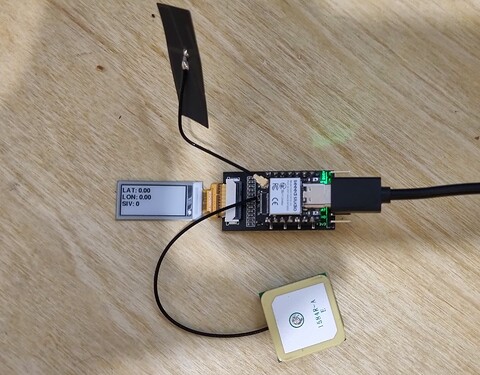Hi there,
Does this run?
#include <SPI.h>
//EPD
#include "Display_EPD_W21_spi.h"
#include "Display_EPD_W21.h"
#include "Ap_29demo.h"
void setup() {
#ifdef ESP8266
pinMode(D0, INPUT); //BUSY
pinMode(D1, OUTPUT); //RES
pinMode(D2, OUTPUT); //DC
pinMode(D4, OUTPUT); //CS
#endif
#ifdef Arduino_UNO
pinMode(4, INPUT); //BUSY
pinMode(5, OUTPUT); //RES
pinMode(6, OUTPUT); //DC
pinMode(7, OUTPUT); //CS
#endif
//SPI
SPI.beginTransaction(SPISettings(10000000, MSBFIRST, SPI_MODE0));
SPI.begin ();
}
//Tips//
/*
1.Flickering is normal when EPD is performing a full screen update to clear ghosting from the previous image so to ensure better clarity and legibility for the new image.
2.There will be no flicker when EPD performs a partial refresh.
3.Please make sue that EPD enters sleep mode when refresh is completed and always leave the sleep mode command. Otherwise, this may result in a reduced lifespan of EPD.
4.Please refrain from inserting EPD to the FPC socket or unplugging it when the MCU is being powered to prevent potential damage.)
5.Re-initialization is required for every full screen update.
6.When porting the program, set the BUSY pin to input mode and other pins to output mode.
*/
void loop() {
unsigned char i;
#if 1 //Full screen refresh, fast refresh, and partial refresh demostration.
EPD_HW_Init(); //Full screen refresh initialization.
EPD_WhiteScreen_White(); //Clear screen function.
EPD_DeepSleep(); //Enter the sleep mode and please do not delete it, otherwise it will reduce the lifespan of the screen.
delay(2000); //Delay for 2s.
/************Full display(2s)*******************/
EPD_HW_Init(); //Full screen refresh initialization.
EPD_WhiteScreen_ALL(gImage_1); //To Display one image using full screen refresh.
EPD_DeepSleep(); //Enter the sleep mode and please do not delete it, otherwise it will reduce the lifespan of the screen.
delay(2000); //Delay for 2s.
#if 1 //Partial refresh demostration.
//Partial refresh demo support displaying a clock at 5 locations with 00:00. If you need to perform partial refresh more than 5 locations, please use the feature of using partial refresh at the full screen demo.
//After 5 partial refreshes, implement a full screen refresh to clear the ghosting caused by partial refreshes.
//////////////////////Partial refresh time demo/////////////////////////////////////
EPD_HW_Init(); //Electronic paper initialization.
EPD_SetRAMValue_BaseMap(gImage_basemap); //Please do not delete the background color function, otherwise it will cause unstable display during partial refresh.
for(i=0;i<6;i++)
EPD_Dis_Part_Time(32,56+24*0,Num[i], //x-A,y-A,DATA-A
32,56+24*1,Num[0], //x-B,y-B,DATA-B
32,56+24*2,gImage_numdot, //x-C,y-C,DATA-C
32,56+24*3,Num[0], //x-D,y-D,DATA-D
32,56+24*4,Num[1],24,32); //x-E,y-E,DATA-E,Resolution 24*32
EPD_DeepSleep(); //Enter the sleep mode and please do not delete it, otherwise it will reduce the lifespan of the screen.
delay(2000); //Delay for 2s.
EPD_HW_Init(); //Full screen refresh initialization.
EPD_WhiteScreen_White(); //Clear screen function.
EPD_DeepSleep(); //Enter the sleep mode and please do not delete it, otherwise it will reduce the lifespan of the screen.
delay(2000); //Delay for 2s.
#endif
#if 0 //Demo of using partial refresh to update the full screen, to enable this feature, please change 0 to 1.
//After 5 partial refreshes, implement a full screen refresh to clear the ghosting caused by partial refreshes.
//////////////////////Partial refresh time demo/////////////////////////////////////
EPD_HW_Init(); //E-paper initialization
EPD_SetRAMValue_BaseMap(gImage_p1); //Please do not delete the background color function, otherwise it will cause an unstable display during partial refresh.
EPD_Dis_PartAll(gImage_p1); //Image 1
EPD_Dis_PartAll(gImage_p2); //Image 2
EPD_Dis_PartAll(gImage_p3); //Image 3
EPD_Dis_PartAll(gImage_p4); //Image 4
EPD_Dis_PartAll(gImage_p5); //Image 5
EPD_DeepSleep();//Enter the sleep mode and please do not delete it, otherwise it will reduce the lifespan of the screen.
delay(2000); //Delay for 2s.
EPD_HW_Init(); //Full screen refresh initialization.
EPD_WhiteScreen_White(); //Clear screen function.
EPD_DeepSleep(); //Enter the sleep mode and please do not delete it, otherwise it will reduce the lifespan of the screen.
delay(2000); //Delay for 2s.
#endif
#if 0 //Demonstration of full screen refresh with 180-degree rotation, to enable this feature, please change 0 to 1.
/************Full display(2s)*******************/
EPD_HW_Init_180(); //Full screen refresh initialization.
EPD_WhiteScreen_ALL(gImage_1); //To Display one image using full screen refresh.
EPD_DeepSleep(); //Enter the sleep mode and please do not delete it, otherwise it will reduce the lifespan of the screen.
delay(2000); //Delay for 2s.
#endif
#endif
#ifdef ESP8266
while(1)
{
Sys_run();//System run
LED_run();//Breathing lamp
}
#endif
#ifdef Arduino_UNO
while(1); // The program stops here
#endif
}
GL  PJ
PJ

from here?
GDEM0097T61_Arduino.zip (11.6 KB)
